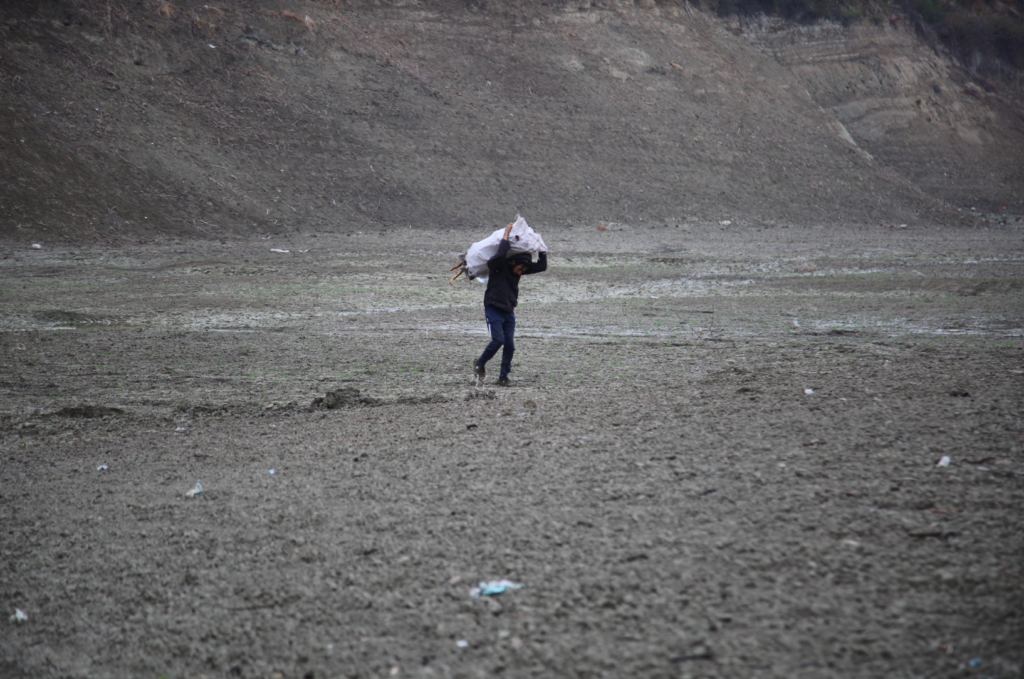
Mohamed Al-Hajj Hassan, a farmer from northwest Syria, lost all his vegetable crops — he had planted 6,5 hectares of eggplants and peppers which ended up never seeing the light of day. Last November, the dry out of the Duwaisat dam near the Turkish border has turned the landscape into a no man’s land on which nothing can grow. ‘‘The water stopped from the dam, and the vegetables all dried up, we were seriously damaged,’’ he recounts. Mohamed is one of thousands of farmers who relied on the reservoir to irrigate their fields. The three-decades-old water source is now only a desert-like scenery, scattered with abandoned boats and animal skulls.

Syria is currently facing its worst drought in nearly 70 years, affecting the livelihoods and food security of at least five million people in the North.
Lotfi Damer, a farmer from Darkush who also benefited from the Duwaisat dam, bears witness to the despair of surrounding communities: ‘‘We had no other source than this dam to provide us with water to irrigate the lands. The farmers who have trees that have died because of the drought have replaced them with winter crops that rely on rainwater because there is no hope from the dam’s water. ’’ But even winter crops did not get enough rainwater this year, and an estimated 25% of rainfed yields have been lost in northern Syria. The lack of water has created a ruthless snowball effect: low levels of water in reservoirs have cut down the energy production capacity causing power blackouts across north-eastern Syria, with only 1 to 2 hours of electricity per day in some locations, according to the International Federation of Red Cross and Red Crescent Societies. Today, 90% of the population in Syria lives below the poverty line.


While this seems to be climate change driven, the cause of the Syrian water crisis may be actually more complex. Global warming is undoubtedly an important factor to people’s suffering, but it’s certainly not the whole picture.
Professor Rami Zurayk, whose research focuses on Arab food security and agriculture, pays particular attention to not attributing everything to the climate crisis. ‘‘This region is used to droughts. Now, climate change makes those droughts more frequent and harsher,’’ Rami Zurayk says, ‘‘but this is not about droughts only. This is about who has the power to control water. ’’
In the North, Syria is dependent on the Euphrates River which originates in Turkey and flows down to Iraq. As an enemy of the Bashar Al-Assad regime, Turkey has been accused to use water shutoffs as a weapon in the conflict— but also as a way to cover for its own water shortages, partly due to the government’s poor resource management. ‘‘Turkey is kind of a political bully in the region when it comes to the waters of the Tigris and the Euphrates ’’ Rami Zurayk explains.
And still, Turkey’s control over water isn’t yet the complete explanation. The liberalisation of the economy and the removal of state subsidies as Bashar Al-Assad seized power in 2000, have their share in today’s crisis too.
Climate change is an enormous threat to the already-vulnerable population of Syria. Though it’s important to tell the whole story.
‘‘When you blame things on climate change only, ’’ Rami Zurayk says, ‘‘it depoliticizes geopolitical issues completely. It becomes no one’s fault. There is no aggression anymore. ’’
Resilience is possible. But it starts by recognizing and dismantling the root causes of suffering: power over resources and geopolitical games.